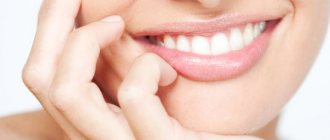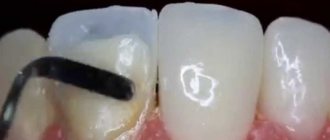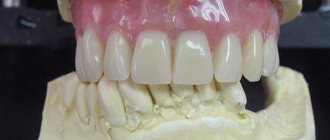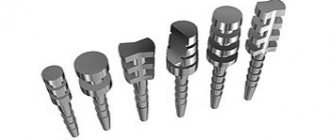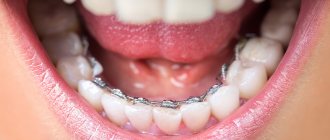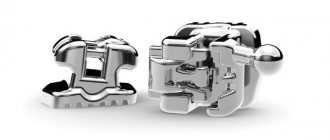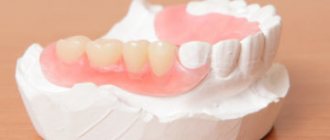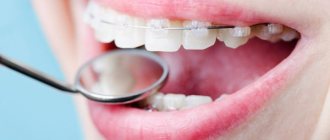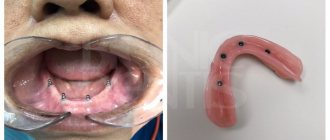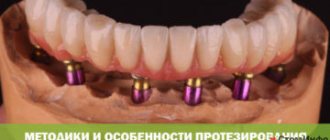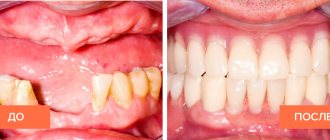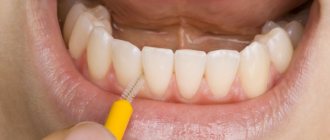Modern people tend to care not only about their dental health.
The aesthetic condition of the oral cavity is becoming increasingly important and in the event of the loss of even one tooth, especially if the void is clearly visible, a person experiences psychological discomfort. It begins to seem to him that everyone notices his shortcomings.
The most popular method of artificial restoration of lost segments of the jaw row is considered to be dental prosthetics, which is understandable. Modern technologies make it possible to do this efficiently and aesthetically.
What is
A butterfly dental appliance is a framed model made of plastic or nylon . Suitable for both permanent and temporary use.
The device owes its name to its original shape - the prosthesis clamps are two semicircular arcs on opposite sides of the frame.
They really resemble butterfly wings. It is capable of replacing both one damaged organ and the entire jaw row, which is especially justified as temporary prosthetics.
We will find out exactly how such prostheses are installed in the patient’s mouth in the following video:
The design refers to removable partial immediate models, which has the following nuances:
- partial – means that the prosthesis is best suited for partial replacement of segments of the jaw row (ideally, one, maximum two organs);
- removable – the user is able to independently dismantle the structure to perform hygiene procedures. The butterfly can be removed conveniently and easily;
- immediate is a Latin term meaning “instantaneous.” The denture can be installed immediately after the tooth extraction procedure.
Depending on the size of the device, the prosthesis changes somewhat - it becomes more like a caterpillar than a butterfly.
Indications for the use of butterfly dentures
Butterfly dentures are removable structures; they are used as temporary prosthetics to replace one, two or three teeth at once while a permanent denture is being manufactured.
They consist of a base (imitation gum) and crowns that imitate real teeth. Along the edges of the dentures there are fasteners in the shape of an open circle, with the help of which the structure is attached to the supporting teeth. Visually, such products resemble a butterfly, which is why they received their unofficial name.
The key feature of immediate dentures is that they cannot be used in completely edentulous patients. Their use is possible in the absence of no more than three dental units in a row. Another important nuance is that this type of prosthetics requires the presence of two supporting teeth on the sides of the defect. Thus, a butterfly cannot replace the outermost tooth in a row.
Such structures can be worn permanently as an alternative to implantation or bridges, however, they are not able to provide a uniform chewing load on the dentition, and therefore bone tissue atrophy is inevitable. Therefore, we recommend wearing immediate dentures for no longer than two months and giving preference to permanent prosthetics.
Varieties
The design has a transparent structure and is almost invisible. The manufacturing technology does not depend on the material - it is identical in both versions.
If there is a need for prosthetics in distant areas of the jaw, high-quality metal alloys with an increased strength coefficient are used.
There are spirit types:
- immediate - a prosthesis with the function of full restoration - for a certain period of time fully replaces lost organs. Typically, this is the time it takes to manufacture a permanent device. Made from nylon or acrylic;
- with the function of partial restoration - their main task is to hide the empty areas formed after tooth extraction, as well as to provide stability and prevent loosening of the remaining areas of the jaw row. The optimal solution is to replace 2-3 teeth.
Find out reviews about nylon dentures in our next publication. And here you can see photos “before” and “after” the installation of lumineers.
Design features
Photo: butterfly denture before and after installation
A butterfly denture is a structure made of nylon or plastic.
. Also, in some cases, for example, when carrying out prosthetic procedures for distant chewing teeth, a high-quality metal alloy can be used. Its use is necessary for more reliable fixation in the patient’s oral cavity.
This device received its name due to its unique shape: the fastening elements of the prosthesis, also called clasps, are located in the form of semicircular arcs on both sides of the product and, to some extent, really resemble the wings of the insect of the same name.
The appearance of the prosthesis is as close as possible to the natural shade of human teeth and tissues; accordingly, it is practically invisible during use.
The only exceptions are those cases when clasps are used, that is, hooks that are made of metal. However, technology of this kind is rarely used for prosthetics of the anterior row of teeth.
There are two main types of products, conditionally separated by the materials used in production:
- Made using plastic or nylon
. Such dentures look absolutely natural and do not create a feeling of discomfort. Their only drawback is the following: they are not attached firmly enough to the oral cavity; therefore, they must be used in combination with special gels and creams that ensure reliable retention of the structure. - Manufactured from high quality metal alloys
. Products of this kind are more durable and adhere perfectly to the teeth, however, they are not without a significant drawback: it is not recommended to use a design of this kind on teeth located in the smile zone, since the metal clasp is noticeable during use.
We invite you to watch a short video to understand even better how this prosthesis looks and is installed:
Indications for installation
The prosthesis has a number of main indications for the use of prostheses - “butterflies”, when such designs are considered the highest priority:
- young people and older schoolchildren, since the installation of stationary, non-removable products at this age is not justified - the bone tissue has not yet been fully formed and is subject to age-related changes. This means that the permanent device may become displaced or deformed as the bone grows;
- as a temporary measure to prevent displacement that may occur during the production of a permanent implant. This will not only strengthen the teeth, but also relieve discomfort and improve the appearance of the oral cavity;
- if the patient refuses to grind adjacent teeth to install other types of structures. However, this is only possible in cases of replacing one tooth;
- the patient is diagnosed with 100% tooth loss;
- before the implantation procedure to restore the thinned area of the jaw. This happens when a patient, having lost one or more organs, refuses prosthetics for a long period of time;
- for dental reasons, when the use of other methods of dental restoration is considered impossible due to the anatomical features of the jaw structure or medical requirements.
Design Features
The “butterfly” prosthesis has a distinctive feature - plastic clasps and fastenings, with the help of which it is firmly attached to adjacent teeth, but without causing any inconvenience to the owner. The supporting teeth must be healthy, because they bear additional stress.
The advantage of such a prosthesis: there is no need to grind down healthy teeth to secure it, as is done when installing bridge structures.
A “butterfly” denture is attached to the gum with plastic hooks to healthy teeth.
The base of the prosthesis is made of plastic, the color matches the color of the gums. Artificial teeth installed on the base are also made of plastic.
The materials for making a butterfly prosthesis can be:
- Nylon. This is an elastic soft material. It performs its functions well in a prosthesis for 1-2 teeth, but in more extended structures its advantages become a disadvantage - the structure bends and sags
- Acrylic plastic. The most popular material in dentistry
- Acry-free. This is acrylic, but without methyl acrylate in the composition. Used as a hypoallergenic material for the manufacture of prostheses for patients with hypersensitivity to conventional plastic
The aesthetics of Acry-free material and nylon are the best. But both of them have insufficient rigidity for full chewing load. While chewing solid food, the patient feels discomfort due to excessive pressure of the prosthesis on the gums.
Contraindications
This type of prosthetics is contraindicated in the following cases:
- absence of supporting teeth or damage to the crowns that replace them;
- inflammatory processes of the oral cavity - both soft tissues and mucous membranes, and bone structures;
- excessive mobility and severe looseness of the jaw areas on which the butterflies should be attached;
- with severe thinning of the hard gum tissue. The only possible way out in such a situation is surgical intervention.
Indications and contraindications for use
A partial removable denture has several absolute indications for installation:
- They are installed on teenagers and young adults, since prosthetics using implants is not practical at this age. The process of formation of the maxillofacial region in young people has not yet been completed. The bones and tissues of the jaws are constantly changing, so an implant installed in deep structures can move, which will lead to a significant defect in both the dentition and the jaw as a whole;
- Preventing tooth movement when one or two teeth are missing. “Butterflies” are installed for the period until permanent structures are made;
- The immediate is installed on one tooth for permanent use if there are contraindications to other prosthetic methods;
- Impossibility of implanting a pin into bone tissue due to the presence of anatomical or physiological features;
- Thinning of the jaw bone during the period of regeneration.
This type of orthodontic structures has virtually no contraindications. Installation of temporary systems is not carried out if:
- Complete absence or severe damage to the dental crowns located on both sides of the cavity, i.e. there is nothing to hook the removable structure to;
- The presence of inflammatory processes in the patient’s oral cavity. In this case, installing and wearing a temporary structure can lead to the development of complications;
- Mobility of the teeth, which will serve as supports for fastening. In this case, the dentist analyzes the condition of the teeth and finds out the reason for their loosening. If this phenomenon is a consequence of disease of the gums and mucous membranes, then after appropriate treatment, dentures can be installed;
- Too much depletion of bone structures, if its restoration is only possible through surgery.
Manufacturing and installation procedure
To achieve maximum comfort from using the device, the prosthesis is made in several stages:
- examination of the condition of the oral cavity and obtaining a complete clinical picture regarding the possibility of installing this type of product;
- taking a jaw cast - if the organ is planned to be removed, this is done before the operation, if the tooth has already been lost - a cavity sample is taken - a cast;
- the sample is transferred to a special laboratory , where the dental technician will make an exact copy of the impression from plastic or nylon (at the patient’s request). After this, the technician will make the clamps according to the shape previously removed from the supporting organs. This is necessary for the most accurate mounting of the device;
- first fitting - the accuracy of the dimensions is checked - this will be the key to the patient’s future comfort, as well as a guarantee that the structure will not shift or deform over time;
- If adjustment of the prosthesis is necessary, it is sent back to the laboratory . If everything is perfect, the structure can be picked up immediately.
If we are talking about a single organ, then the manufacturing scheme is extremely simple; in the case of replacing a large number of teeth, the fitting is carried out more carefully, and the measurements are often corrected again.
Features of the technique and procedure of prosthetics
Butterfly dentures are most often installed immediately after the removal of a diseased or decayed tooth, but installation is also possible some time after extraction.
The structures perform several important tasks at once:
- chewing function support;
- masking a missing tooth;
- protection of soft tissues from bacteria and infection;
- prevention of inflammation, periodontal disease and other pathologies;
- temporary dentures prevent the displacement of adjacent teeth and their deformation.
This is an excellent option while making a permanent prosthesis, such as a bridge. They guarantee the patient comfort and the absence of cosmetic defects, are practically invisible in the mouth, and the materials in immediate dentures successfully imitate natural crowns and gums.
And most importantly, the structures have no contraindications and can be installed for any characteristics of the oral cavity and for any physical condition of the patient.
Prosthetics takes place in several simple steps:
- examination and consultation;
- treatment of diseased supporting teeth;
- hygienic cleaning, removal of tartar and deposits, sanitation of the oral cavity;
- taking an impression and making a prosthesis;
- fitting, correction and final installation.
Thus, you receive a ready-made prosthesis in just two visits to the clinic. And this is with the complete absence of pain, surgical intervention and a more than affordable price.
Manufacturing and installation of immediate dentures in our clinic takes only a couple of days.
It is important to consider that butterflies are removable dentures. It is recommended to remove them at night and clean them regularly. If not properly cared for, food debris can become clogged underneath them, bacteria can multiply, inflammation can develop, not to mention such phenomena as bad breath.
Advantages
Like any type of prosthesis, a butterfly has its pros and cons.
As a temporary replacement, the design has a number of advantages that distinguish it from analog devices:
- complete absence of age restrictions;
- budget pricing policy – the cost of butterflies is designed for patients with any income level. At the moment this is the cheapest method of prosthetics;
- ease of manufacture;
- quick installation that does not require preliminary preparation - turning, grinding. As a rule, just one or two visits to a specialist are enough - and the job is done;
- maximum level of comfort during wearing - there is practically no period of adaptation, and there is no talk of pain at all;
- caring for the structure is simple and convenient. It is quickly removed from the oral cavity, and does not require the purchase of an expensive cleaning device - improvised means are enough to process the model;
- Reliable fixation of the product does not require special skills;
- immediate successfully copes not only with an aesthetic, but also with a protective task - it effectively prevents food debris from getting into the tooth socket;
- preserve the integrity of the hard tissue of the jaw, preventing the process of its atrophy;
- allows installation in the diagnosis of periodontal disease and other gum pathologies;
- do not cause allergies and are not subject to oxidative processes.
We will tell you and show photos which teeth are best to insert. And also from our article you will learn the advantages and disadvantages of prosthetics and implantation. In the following review: https://dentist-pro.ru/protezirovanie/nesemnye/koronki/na-zuby-kakie-luchshe.html we looked at the types of crowns and their cost.
And here we described the features of caring for removable dentures at home.
Description of the butterfly prosthesis
The “butterfly” prosthesis belongs to the category of immediate prostheses, which translated from English means “immediate, urgent.” This name reflects the main advantage of urgent prosthetics - minimal installation time. Urgent dental prosthetics involves the installation of an immediate component over several hours. This is the cheapest and most painless way to install an artificial false tooth in place of a lost one. At the same time, the “butterfly” prosthesis is no different in appearance from a real tooth.
READ ALSO: Which dentures are best for chewing teeth?
The word “immediate” refers to a removable temporary structure designed to fix teeth located adjacent to the lost ones. Installed for the period of preparation for permanent dentures. This preparation may be related to gum healing after surgery. When implanting an implant, a significant period of time is required for the jaw system to adapt to the introduction of a foreign body. The immediate tooth successfully imitates a natural tooth; it is secured to adjacent teeth using clip-on attachments in the form of wings. This is where the name “butterfly” comes from. Clippers fix the artificial tooth and prevent injury to the gums, and also serve as aesthetic compensation.
The material for making a “butterfly” can be acrylic or nylon, sometimes metal. Metal clippers provide a more secure hold on crowns. Nylon or acrylic clippers are traditionally placed on the front teeth because the metal is visible in the mouth. Acrylic and nylon differ somewhat in properties and price (acrylic products are cheaper). Properties of acrylic in comparison with nylon:
- Nylon is more flexible than acrylic, bends well, and is almost impossible to break. Acrylic failures are much more common.
- Acrylic is translucent and does not fully imitate gums. Nylon is completely transparent and invisible in the patient's mouth.
- It releases toxic substances, albeit in microscopic quantities; nevertheless, acrylic can cause allergies. The dentist is obliged to warn the patient about this and find out whether he is susceptible to allergic reactions.
- Acrylic is more porous than nylon, so it requires especially careful care.
- The weight of both materials is approximately the same, both types are worn without pain or discomfort.
- The service life of acrylic products is longer - nylon products wear out and deform faster.
- Acrylic is less rough than nylon.
- Acrylic clasps are more rigid and better transfer the load to the chewing teeth, which prevents diseases of the gums and bone tissue. Often, for inconspicuous teeth, metal fasteners are used, which best ensures the strength of the structure.
Flaws
The disadvantages of the device include the following shortcomings inherent in this type of prosthetics:
- Since the butterfly is intended primarily for temporary, short-term use, the design is not as durable as other analogues. They quickly become unusable, which, if necessary, requires re-installation;
- if the “butterfly” is made of nylon, which is considered an even more fragile material, you will have to abandon products that are too hard for a while;
- when worn constantly, it provokes atrophy of bone tissue;
- not too strong degree of fixation;
- impossibility of attachment due to congenital defects in the structure of abutment teeth;
- Once damaged, a device cannot be repaired.
Pros and cons of immediate prosthetics
Prosthetics using butterfly prostheses has a number of advantages:
- If due to bone atrophy it is not possible to place an implant, then a temporary orthodontic design will help restore the chewing functions of the jaws during the period of tissue regeneration;
- Hypoallergenic materials are used in production, so they do not cause allergic reactions when worn;
- Speed of production and installation. A denture for one tooth can be made and put in place in two visits to the dentist;
- The elasticity of acrylic models provides a high level of comfort. The artificial tooth is practically not noticeable in the mouth;
- Easy care. It is enough to rinse the removable model with clean water and, if necessary, clean it with a soft-bristled toothbrush;
- Soft elastic materials ensure a tight fit of the structure to the gum, minimizing the level of discomfort;
- Aesthetic appearance. The artificial tooth looks natural and does not stand out from the general dentition;
- Installation of immediates does not require grinding of the supporting teeth;
- During installation, gums are not injured;
- Relatively affordable price;
- Can be installed on patients of any age.
Compared to the advantages, these designs have few disadvantages:
• When using intermediates, you must follow a certain diet, namely:
- exclude from the diet foods containing chemical acids (vinegar);
- exclude solid foods, especially if the denture is installed on the front tooth (when biting off solid food, it may become deformed or break).
• Without the use of a special fixing composition, the product is not held securely enough in the oral cavity.
• The insufficient strength of acrylic materials leads to rapid failure of the structure.
Wearing rules and service life. Care
There is nothing complicated in the process of wearing and caring for the product. Since the main components from which they are made are absolutely safe, environmentally friendly and, from a biological point of view, inert, they are not a favorable environment for the proliferation of pathogenic microorganisms and bacteria.
They do not support chemical reactions with food substances and saliva. The main thing that should be done regularly is that after each meal, the structure must be removed and rinsed well with warm water, and once a day treated with a special composition for dentures.
If in the first days there are unpleasant sensations in the form of a slight impairment of diction, you should speak more, and after a day or two, the function will be restored.
You should also acquire some skills on how to take off and put on a bow tie. You should spend some time doing this in front of a mirror, then it will become automatic.
As for meals, you should adhere to some restrictions - exclude solid foods, and try to ensure that the portions entering the oral cavity are not too large.
Nylon immediate dentures
Nylon dentures are soft, flexible, and elastic. They are very comfortable, do not require long adaptation, and within a few hours after installation you will forget about them and stop noticing them.
Nylon structures are as close as possible to natural fabrics and look just like real crowns and gums. For this reason, it is recommended to install nylon dentures in the smile area.
They do not rub the soft tissues of the oral cavity, are easy to put on, and are firmly fixed. When installing them, the risk of injury is eliminated, which guarantees the absence of inflammation and gum disease.
Nylon is a material that does not contain metals or monomers, and therefore does not provoke allergies. It is easy to clean and is not a favorable environment for the growth of germs and bacteria. Prostheses based on it are as hygienic as possible.
When chewing hard food, nylon structures can become deformed and require careful use. They are somewhat more expensive in price than their acrylic counterparts, but this is compensated many times over by their convenience and practicality.
Alternatives
Unfortunately, there are not so many designs that could be used to replace the butterfly prosthesis on an alternative basis. And even those types of products will not be able to compete in price with immediate prostheses, since the high cost of other models, as a temporary option, is unlikely to find many supporters. The most optimal substitutes:
- clasp dentures – metal frame with plastic filling. Suitable in case of major organ loss, when implantation is contraindicated;
- nylon - they are similar to the butterfly model only by the base material, which also atrophies bone tissue with constant use.
Prices
The pricing policy of the product refers to budget options . Depending on the region, the status of the clinic and the qualifications of the orthopedic doctor, it may vary.
If we compare on average, then depending on the material, the cost of the service will look like this:
- acrylic is the cheapest - depending on the number of teeth that the prosthesis will replace, you will have to pay 5-7 thousand rubles for the product;
- a nylon bowtie costs a little more - about 10 thousand;
- if the device contains metal inclusions, the price will be approximately 20-25 thousand rubles, but even this amount is several times cheaper than other types of restoration.
How much does a nylon bowtie cost?
The price of prosthetics depends on the number and location of lost teeth. Prices are published on the clinic's website.
Expert of the article Alekperov Roman Borisovich Dentist-orthopedist, doctor of the first category
Work experience 24 years.
Sign up for a consultation
three ROOTT specialists + diagnostics as a gift
All specialists Our specialists
The doctors and technicians of the ROOTT Center, respecting the patient’s wishes to solve the problem of missing one or two teeth in the shortest possible time with the greatest possible comfort, professionally install nylon “butterflies”... in one visit.
Shiyka Oksana Grigorievna
dentist-therapist
Popkov Sergey Yurievich
orthopedic dentist, candidate of medical sciences
0:45
